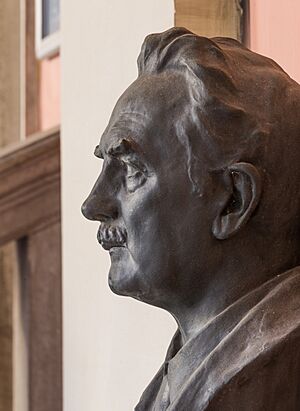Hans Molisch facts for kids
Hans Molisch (born December 6, 1856, in Brünn, now Brno, Czech Republic – died December 8, 1937, in Wien, Austria) was an important botanist from the Czech Republic and Austria. He studied plants and how they work.
Contents
What is Molisch's Test?
You might know his name from something called the Molisch's test. This is a special chemical test that scientists use to find out if a substance contains carbohydrates, which are things like sugars and starches. It's a very sensitive test, meaning it can detect even small amounts of carbohydrates.
A Life of Teaching and Discovery
Hans Molisch was a professor at several famous universities around the world. He taught at the German University of Prague starting in 1894. Later, he taught at Vienna University from 1909 to 1928. He even traveled far to teach in Japan at Tohoku Imperial University (now Tohoku University) from 1922 to 1925, and in India at the Bose Institute in Kolkata in 1928.
From 1931 to 1937, he was the vice-president of the Austrian Academy of Sciences. This shows how respected he was in the scientific community.
His Work with "Starch Pictures"
Molisch built on the work of another scientist named Julius von Sachs. He found a clever way to make "starch pictures" inside real leaves. He would place photographic negatives (like the old film used in cameras) over leaves that were getting light. This method helped him study how plants make and store starch.
Books by Hans Molisch
Hans Molisch wrote many books about his scientific discoveries. Here are some of his well-known works:
- Die Pflanzen in ihren Beziehungen zum Eisen (Plants and Their Connection to Iron), 1892
- Leuchtende Pflanzen (Glowing Plants), 1904
- Die Purpurbakterien (The Purple Bacteria), 1907
- Die Eisenbakterien (The Iron Bacteria), 1910
- Mikrochemie der Pflanzen (Microchemistry of Plants), 1913
- Pflanzenphysiologie (Plant Physiology), 1920
- Pflanzenphysiologie in Japan (Plant Physiology in Japan), 1926
- Im Lande der aufgehenden Sonne (In the Land of the Rising Sun), 1927


